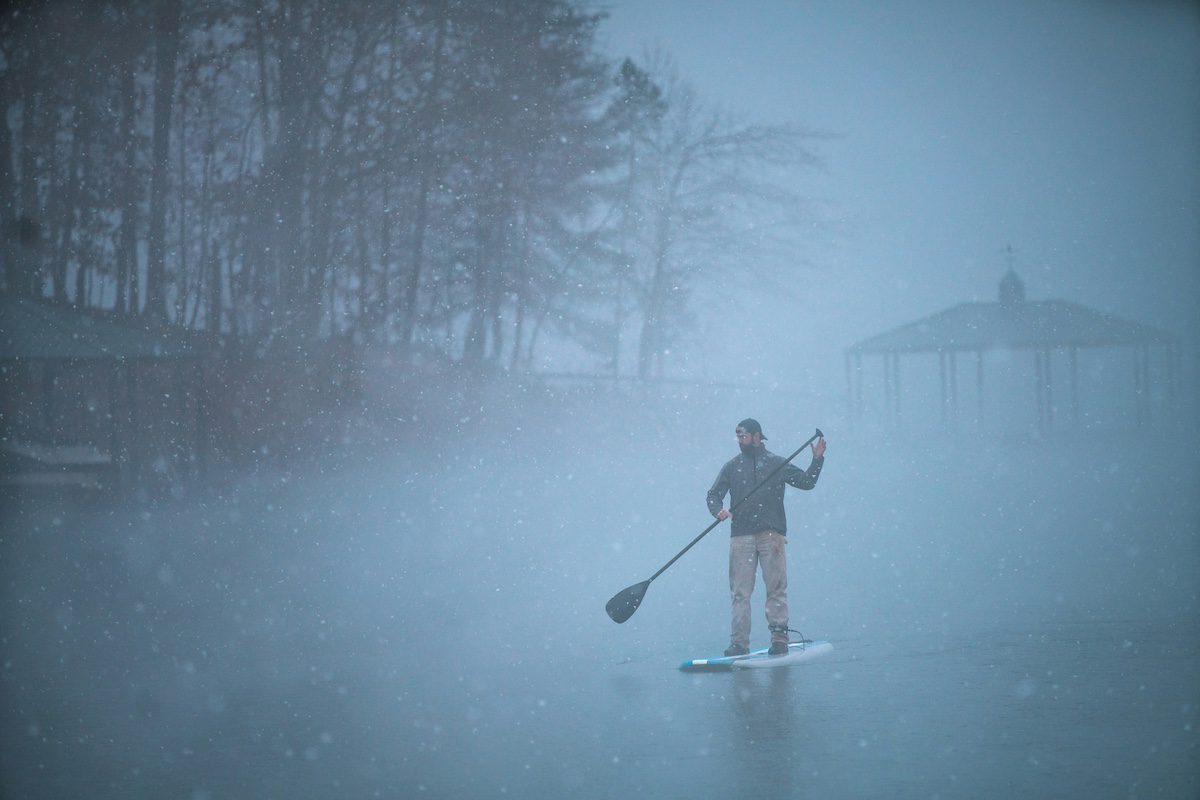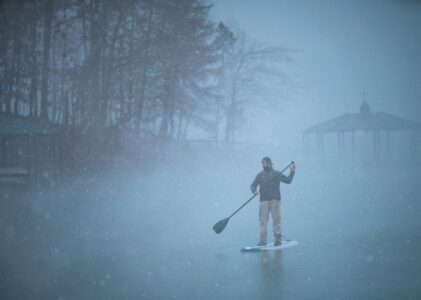When most people think of paddleboarding, they envision warm, sunny days spent gliding across calm waters. However, for those looking to take their paddleboarding skills to the next level and embrace the beauty of winter, paddleboarding in cold weather can be a thrilling and unique experience. In this article, we’ll explore the world of winter paddleboarding, from the gear you need to the best locations to embark on this frosty adventure. Get ready to discover the exhilaration of paddleboarding in winter!
Preparing for Your Winter Paddleboarding Adventure
Before you hit the icy waters, proper preparation is essential. Winter paddleboarding demands a different approach compared to the summertime version of this sport. Here are some tips to ensure you’re ready for your cold-weather adventure:
1. Choose the Right Paddleboard
When paddleboarding in winter, your choice of equipment can make or break your experience. Opt for an all-around or touring paddleboard with a stable design and good flotation. In cold water, stability is key to staying safe. A wider board with a larger surface area will provide better stability, making it easier to balance in potentially challenging conditions.
2. Invest in a Quality Wetsuit or Drysuit
Cold water requires proper insulation to keep you warm and safe. A high-quality wetsuit or drysuit is essential for paddleboarding in winter. Wetsuits are ideal for milder winter conditions, while drysuits are better suited for extremely cold waters. Ensure a snug fit to prevent water from seeping in, and consider layering for extra warmth.
3. Wear the Right Accessories
Protecting your extremities is crucial when paddleboarding in winter. Invest in neoprene gloves, booties, and a hood to keep your hands, feet, and head warm. Don’t forget to wear a life jacket or personal flotation device (PFD) for added safety – even experienced paddlers should prioritize safety.
4. Check the Weather and Water Conditions
Before heading out, thoroughly check the weather forecast and water conditions. Winter weather can be unpredictable, so it’s essential to be well-informed. Pay attention to wind speed, currents, and any potential hazards. Avoid paddleboarding in freezing temperatures, as this can lead to dangerous situations if you fall into the water.
5. Choose the Right Location
Not all bodies of water are suitable for winter paddleboarding. Opt for sheltered lakes, calm rivers, or protected coastal areas with minimal boat traffic. These locations tend to have calmer waters and are less affected by strong winds, making them ideal for a winter paddleboarding adventure.
Tips for a Safe and Enjoyable Winter Paddleboarding Experience
Once you’ve prepared properly, it’s time to hit the water and enjoy the unique beauty of winter paddleboarding. Here are some tips to ensure your adventure is safe and enjoyable:
1. Start Slow and Gradual
Paddleboarding in cold weather requires a bit of adjustment, both mentally and physically. When you’re new to winter paddleboarding, it’s essential to take it slow and ease into the experience. Start with shorter sessions to get accustomed to the colder water and weather conditions.
As you become more comfortable with the cold, gradually increase the duration of your paddleboarding sessions. This approach will allow your body to adapt to the lower temperatures and help you build the necessary stamina for longer journeys in the winter.
2. Stay Hydrated and Nourished
Staying hydrated and well-nourished is just as crucial in cold weather as it is in the heat. Even though you may not feel as thirsty as you would on a hot summer day, your body still loses fluids through respiration and sweat. Therefore, it’s important to drink water regularly during your winter paddleboarding adventure.
Additionally, bring along high-energy snacks like granola bars, nuts, or dried fruits to keep your energy levels up. The cold weather and physical exertion can deplete your energy more quickly than you might expect, so having a snack on hand can make a big difference in maintaining your strength and focus.
3. Be Aware of Hypothermia
Hypothermia is a real concern when paddleboarding in cold water. It occurs when your body loses heat faster than it can produce it, leading to a dangerously low core body temperature. Recognizing the signs of hypothermia is crucial for your safety:
- Uncontrollable shivering
- Numbness or tingling in extremities
- Confusion or impaired coordination
- Slurred speech
- Fatigue or drowsiness
If you or anyone in your group experiences these symptoms, it’s essential to take immediate action:
- Get out of the water and onto dry land.
- Remove wet clothing and replace them with warm, dry layers.
- Seek shelter and warmth.
- Wrap yourself in a blanket or warm clothing to help raise your body temperature.
If symptoms persist or worsen, seek medical attention promptly.
4. Practice Cold Water Safety
Safety should always be a top priority when paddleboarding in winter. Even if you’re an experienced paddler, it’s important to take precautions:
- Paddle with a Buddy: Whenever possible, paddle with a friend or a group. Having someone with you can provide assistance in case of emergencies and make the experience more enjoyable.
- Inform Someone on Land: Before you head out on the water, inform a trusted person on land about your paddleboarding plans. Share your expected return time and your planned route. In case something goes wrong, someone will be aware of your whereabouts and can call for help if needed.
- Carry Safety Gear: Ensure you have essential safety gear, including a life jacket or personal flotation device (PFD), a whistle, and a waterproof communication device like a VHF radio or a smartphone in a waterproof case.
- Know Your Limits: Be aware of your own skill level and comfort zone. Avoid taking unnecessary risks, especially in challenging winter conditions. It’s better to turn back or stay onshore if you feel unsure or unsafe.
- Check Equipment: Before each winter paddleboarding session, inspect your equipment for any signs of wear or damage. Make sure your paddle, leash, and other gear are in good condition to prevent any unexpected issues on the water.
By following these safety practices, you can minimize the risks associated with winter paddleboarding and ensure a safer and more enjoyable experience.
5. Embrace the Winter Scenery
Winter paddleboarding offers a unique opportunity to connect with nature in its serene, frozen state. While staying safe is paramount, don’t forget to take in the breathtaking winter scenery around you. The landscapes of snow-covered trees, frozen shores, and icy waters create a magical ambiance that’s entirely different from what you’d experience in warmer months.
Take moments to appreciate the silence interrupted only by the sound of your paddle slicing through the water. Observe wildlife adapted to the cold, such as birds and seals, which may be more visible during winter. Embrace the peacefulness of the season, and let the beauty of the winter landscape enhance your paddleboarding adventure.
In conclusion, paddleboarding in winter can be a truly remarkable experience, allowing you to connect with nature in a unique and rewarding way. By following these expanded tips for safety and enjoyment, you’ll be well-prepared to embark on your winter paddleboarding adventure with confidence and a deep appreciation for the wonders of the season. So, bundle up, stay safe, and make lasting memories on the icy waters of winter!
Exploring Winter Paddleboarding Destinations
Now that you’re well-prepared and equipped with safety tips, let’s explore some fantastic winter paddleboarding destinations that offer unforgettable experiences:
1. Lake Tahoe, California/Nevada
Lake Tahoe, situated on the border of California and Nevada, is a stunning location for winter paddleboarding. The crystal-clear waters surrounded by snow-covered mountains create a picturesque setting. Be sure to check local regulations and weather conditions before embarking on your adventure here.
2. St. Lawrence River, Quebec, Canada
For a true winter wonderland experience, head to the St. Lawrence River in Quebec, Canada. Paddle among ice floes and enjoy breathtaking views of the frozen landscape. Keep an eye out for seals and other wildlife that thrive in the cold waters of the river.
Explore Quebec’s Winter Wonders
3. Lake Placid, New York
Lake Placid, nestled in the Adirondack Mountains of New York, is another excellent winter paddleboarding destination. Surrounded by a pristine forest and framed by snow-covered peaks, this lake offers a tranquil and scenic paddleboarding experience.
4. Lake Bled, Slovenia
Venture to Europe for a unique winter paddleboarding adventure on Lake Bled in Slovenia. With its picturesque island and medieval castle perched on a hilltop, Lake Bled is a fairy-tale destination. Paddleboarding on the calm waters of the lake surrounded by snowy mountains is an experience you won’t forget.
5. Puget Sound, Washington
Puget Sound in Washington State offers a diverse winter paddleboarding experience. You can explore urban areas like Seattle or venture into more remote locations, such as the San Juan Islands. The sound’s protected waters provide a relatively calm environment, perfect for winter adventures.
Paddleboarding in winter
Paddleboarding in winter is an exhilarating way to experience the outdoors in a whole new light, quite literally. As you glide through icy waters, surrounded by serene winter landscapes, you’ll gain a deeper appreciation for the beauty of nature in its frozen state. Just remember to prioritize safety, plan your adventure carefully, and choose the right gear. Whether you’re exploring the frozen lakes of North America or the charming lakes of Europe, a winter paddleboarding adventure is sure to create lasting memories and a profound connection with nature’s winter wonders.
So, bundle up, grab your board, and embark on a winter paddleboarding journey that will leave you with stories to share and a sense of accomplishment that only winter adventurers can understand. Get ready to paddle through a winter wonderland like never before!
*Disclaimer: Paddleboarding in winter can be hazardous. Always prioritize safety, wear appropriate gear, and consider seeking professional instruction

